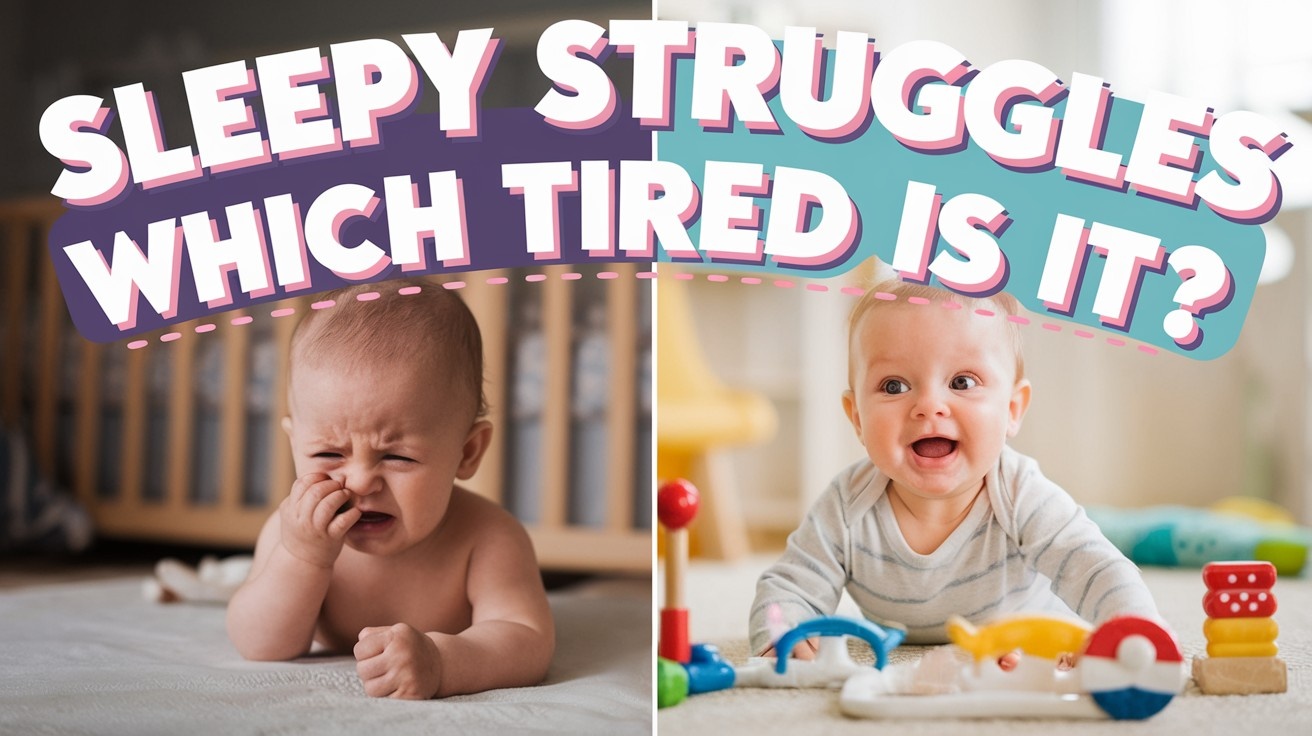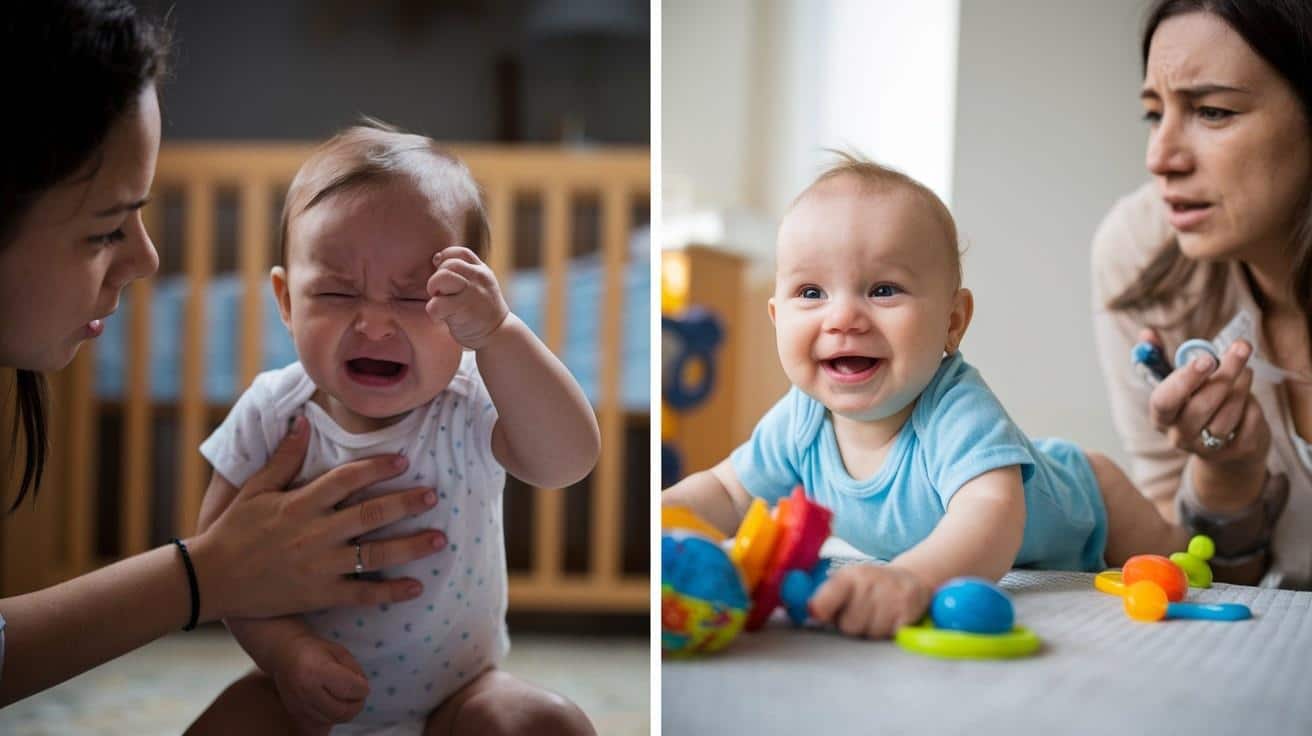
Every parent knows the magical sound of a peaceful baby’s snores, yet achieving that blissful state often feels like solving a complex puzzle. Baby sleep challenges frequently stem from an unexpected source: timing.
When your little one misses their sleep window, they can become either overtired or undertired—two distinct states with dramatically different solutions.
Surprisingly, babies spend about 50% of their sleep time in REM sleep compared to adults’ 20%, making their sleep patterns uniquely sensitive to timing.
The overtired vs undertired baby dilemma represents one of the most common yet confusing challenges for parents.
An overtired baby fights sleep despite desperately needing it, while an undertired baby isn’t ready to sleep yet.
Recognizing these opposing states through your baby’s unique cues can transform bedtime from a battleground to bliss and help everyone in the household get the rest they deserve.
Overtired vs Undertired Baby: Understanding Sleep Disruptions
Overtired refers to when a baby has passed its optimal sleep window. This occurs when a baby stays awake longer than its body can handle.
The brain releases stress hormones like cortisol and adrenaline, making it harder for the baby to fall asleep despite extreme fatigue.
Undertired happens when a baby is put to sleep before they’re ready. This usually results from following strict sleep schedules without considering the baby’s actual sleep needs. The baby may have insufficient sleep pressure (homeostatic drive) to fall asleep easily.
Both conditions disrupt sleep but in opposite ways. Overtired babies fight sleep despite needing it, becoming increasingly fussy and difficult to soothe.
Undertired babies, however, may resist sleep because they aren’t tired enough yet. They might play in bed and seem happy at bedtime, but they take a long time to fall asleep.
Understanding your baby’s sleep cues and ideal wake windows helps avoid both conditions.
Signs of an Overtired Baby

Recognizing when your baby is overtired is crucial for helping them get the rest they need. Babies often display clear signals when they’ve passed their optimal sleep window.
Fussiness and irritability are typically the first signs to appear. Your baby may become increasingly cranky and difficult to soothe.
Eye rubbing and excessive yawning are classic physical indicators of fatigue. These self-soothing behaviors show your baby is trying to manage their tiredness.
Sleep difficulties paradoxically increase when babies are overtired. Their bodies produce stress hormones that make it harder to fall and stay asleep.
The “second wind” phenomenon occurs when overtired babies appear suddenly energetic. This hyperactivity is actually their body’s stress response fighting fatigue.
A common scenario is that 9-month-old Emma missed her afternoon nap due to a doctor’s appointment. By dinner, she’s alternating between tears and manic giggles, fighting sleep despite obvious exhaustion.
Signs of an Undertired Baby

The baby seems happy and alert but won’t sleep: Some babies fight sleep despite being tired because they’re actually not tired enough. Your little one might appear cheerful and engaged, playing happily when you expect them to be ready for sleep.
This can easily be confused with overtiredness, as both states often involve sleep resistance.
Short naps or skipping naps: An undertired baby may take brief “cat naps” of 20-30 minutes or refuse naps entirely. They haven’t built up enough sleep pressure to sustain longer periods of rest.
Parents often mistake this pattern for overtiredness since the behaviors look similar.
Lots of energy near bedtime: If your baby gets a second wind and becomes particularly active or giggly as bedtime approaches, they may need more awake time.
This energetic burst is frequently misinterpreted as overtiredness when it’s actually your baby telling you they’re not ready to sleep yet.
Overtired vs. Undertired Baby: Key Differences
1. Behavior Patterns
| OVERTIRED BABY | UNDERTIRED BABY |
|---|---|
| • Fussy and inconsolable crying | • Playful and active |
| • Arching back, pulling away | • Alert and engaged |
| • Difficult to settle | • Resists sleep attempts |
| • May seem “wired” or hyperactive | • Fidgety during sleep routine |
| • Increased sensitivity to stimulation | • Maintains a good mood |
| • May fight sleep intensely | • Makes eye contact, smiles |
2. Timing Indicators
| OVERTIRED BABY | UNDERTIRED BABY |
|---|---|
| • Awake longer than the age-appropriate window | • Shortened awake periods |
| • Multiple failed nap attempts | • Waking early from naps |
| • Takes longer than 20 minutes to fall asleep | • Becomes cranky shortly after waking |
| • Shortened naps (less than one sleep cycle) | • Consistently wakes happy from naps |
| • Frequent night-waking | • Takes a long time to show sleep cues |
| • Early morning waking | • Fights bedtime but sleeps well once asleep |
3. Physical Signals
| OVERTIRED BABY | UNDERTIRED BABY |
|---|---|
| • Red eyebrows/eyelids | • Bright-eyed, no eye rubbing |
| • Yawning excessively | • Minimal or no yawning |
| • Eye rubbing | • No ear pulling |
| • Ear pulling | • Body remains relaxed |
| • Clenched fists | • Open hands |
| • Facial grimacing | • Animated facial expressions |
Why It Matters: Impact on Baby’s Sleep and Mood

Understanding your baby’s sleep needs is crucial for their overall development and happiness. Recognizing if your baby is overtired or undertired can change their sleep patterns and dramatically improve their mood and well-being.
How Chronic Overtiredness Affects Development and Mood?
Chronic overtiredness in babies can significantly impact their cognitive development and emotional regulation.
When consistently sleep-deprived, babies may struggle to process new information and form crucial neural connections during this period of rapid brain growth.
Overtired babies often display increased irritability, fussiness, and difficulty being soothed. This heightened state of stress can elevate cortisol levels, potentially affecting long-term emotional development and making it harder for them to establish healthy sleep patterns.
How Undertiredness Disrupts Sleep Routines?
Contrary to popular belief, an undertired baby may resist sleep just as much as an overtired one. When babies haven’t expended sufficient energy during their wake windows, they often fight naps and bedtime, leading to fragmented sleep.
This undertiredness can create a confusing cycle where babies appear tired but cannot sustain sleep.
Recognizing the subtle differences between overtiredness and undertiredness is crucial for parents seeking to establish consistent sleep patterns that support their baby’s growth and development.
Fixing the Problem: Tips for an Overtired Baby
Ideal Wake Windows by Age: Newborns need frequent naps every 45-60 minutes, while 3-6-month-olds can stay awake for 1.5-2.5 hours. Older babies gradually extend to 2-3 hour wake windows, with 12-month-olds typically needing two naps totaling 2-3 hours.
Creating a Soothing Bedtime Routine: Consistent bedtime rituals signal it’s time to sleep through predictable activities. Try a warm bath, gentle massage, feeding, and a quiet story in dim lighting.
Begin your routine 30 minutes before your desired sleep time. Consistency matters more than perfection, as babies thrive on knowing what comes next.
Calming Techniques and Quiet Time: White noise machines mimic comforting womb sounds while blocking household disturbances. Gentle rocking or swaying recreates the motion babies experienced before birth.
Darkened rooms with minimal stimulation help overtired babies reset. Brief periods of quiet holding can help overwhelmed infants regulate their breathing and transition to sleep.
Fixing the Problem: Tips for an Undertired Baby
Adjusting nap schedules is crucial for combating tiredness in babies. Consider gradually shortening naps or eliminating them if your baby consistently fights bedtime or wakes frequently at night.
Increasing physical activity and stimulation helps babies expend more energy during wake windows. To promote better tiredness at bedtime, encourage tummy time, interactive play, and age-appropriate sensory activities.
Avoiding too-early bedtimes can prevent split nights and early morning wakings. Watch for genuine tiredness cues rather than following a strict schedule, and consider pushing bedtime later by 15-30 minutes if your baby seems undertired.
Remember that finding the right balance takes time and observation. Each baby’s sleep needs differ, so adjust gradually while monitoring how changes affect overall sleep patterns and mood.
Balanced Baby Sleep Schedules

A well-balanced sleep schedule is crucial for your baby’s development and mood. Rather than rigid routines, focus on appropriate wake windows for your baby’s age.
3-Month Sleep Schedule:
Newborns need 14-17 hours of sleep daily with 45-60-minute wake windows. Watch for eye rubbing, yawning, or fussiness as signs of tiredness.
Aim for 4-5 naps throughout the day, with the longest stretch at night.
6-Month Sleep Schedule:
At this age, babies typically need 12-15 hours with 2-3 hour wake windows—most transition to 3 naps per day with longer stretches of nighttime sleep.
1-Year Sleep Schedule:
Toddlers generally need 11-14 hours with 3-4-hour wake windows. Two naps are common, with some transitioning to one longer midday nap.
Remember that each baby is unique—adjust based on your child’s cues and needs.
When to Seek Help?
While occasional sleep difficulties are normal for young children, persistent problems deserve professional attention.
If your child’s sleep challenges continue despite consistent bedtime routines and environment adjustments, it may be time to consult an expert.
Watch for concerning signs like excessive night sweating, snoring, gasping during sleep, or extreme difficulty settling.
These may indicate underlying conditions such as sleep apnea, reflux, or sensory processing differences requiring medical intervention.
Your pediatrician can rule out medical causes and refer you to specialists if needed. At the same time, sleep consultants offer personalized strategies based on your family’s specific circumstances and your child’s developmental needs.
Final Words
Overtired babies show fussiness, eye-rubbing, and back-arching and struggle to fall asleep despite exhaustion, while underwired babies resist sleep, take short naps, and remain alert when they should be ready for rest.
Both conditions cause sleep difficulties, but timing offers clues—overtired babies struggle after missed sleep windows, while underwired babies resist being put down too early.
Trust your parental instincts to recognize your baby’s unique tiredness signals. Remember that improving sleep requires patience and consistency.
Small adjustments to nap schedules and bedtime routines can significantly enhance your baby’s sleep quality.
If you’re interested in more informational content on mothers and babies, feel free to click here and explore other blogs that you might enjoy.
